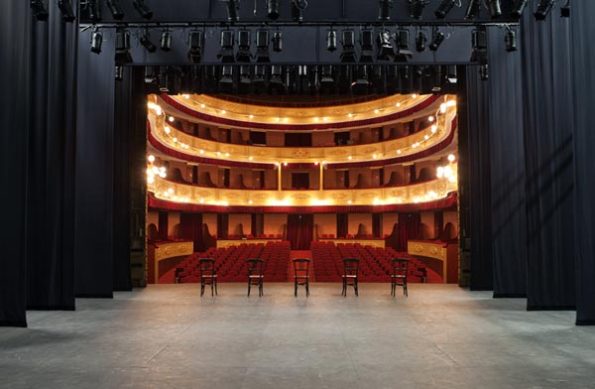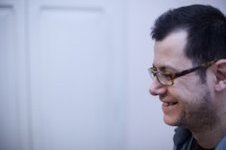Search
To search for an exact match, type the word or phrase you want in quotation marks.
A*DESK has been offering since 2002 contents about criticism and contemporary art. A*DESK has become consolidated thanks to all those who have believed in the project, all those who have followed us, debating, participating and collaborating. Many people have collaborated with A*DESK, and continue to do so. Their efforts, knowledge and belief in the project are what make it grow internationally. At A*DESK we have also generated work for over one hundred professionals in culture, from small collaborations with reviews and classes, to more prolonged and intense collaborations.
At A*DESK we believe in the need for free and universal access to culture and knowledge. We want to carry on being independent, remaining open to more ideas and opinions. If you believe in A*DESK, we need your backing to be able to continue. You can now participate in the project by supporting it. You can choose how much you want to contribute to the project.
You can decide how much you want to bring to the project.

Bòlit presents a project by Job Ramos divided between two spaces; on the one hand an exhibition with objects that deny the documentary feel that we sometimes want to grant art. On the other, Ramos situates the art spectator within a theatre stage, to later enter into the space just below the stage, to experience a piece that we aren’t sure if it is being represented or if it is recorded. Sound and control, from references to politically charged radio, to the theatre of everyday life.
Between the name of the agency American Committee for Liberation from Bolchevism and the transmitter that it set up in the mid fifties, Radio Liberty, there is a nuance in the terminology that is probably not anodyne: the persecution of communism, by the United States, that took place as much inside as outside, in the first years of the Cold War, didn’t delay in presenting itself to the world not as a “liberation from” but as a promotion of “freedom” within a set of absolute parameters. In relation to the practice of art, it is equally known that abstract expressionism also served the cause of positioning a country and a political and economic system, determined as exponents of a freedom that the canvases of painters such as Jackson Pollock or Willem de Kooning endorsed as fully realisable. Financed by the CIA, Radio Liberty took charge of disseminating anti-communist propaganda, but also the whole ideology of the American way of life, to the western world and, in particular, filtering and reminding the old USSR of it, thanks to the geostrategic position the transmitter had on the beach at Pals.
Twilight Immunity takes its name from the time of day when broadcasting towards the soviet block was practically indecipherable from this point of the Costa Brava. Job Ramos, first of all, locates his project as a commission that he received for the development of a case study in relation to the transmitter, primarily within the framework of the exhibition “Camps invisibles”, curated by José Luís de Vicente and Honor Hager at the Arts Santa Monica at the end of 2011. However, the artist rapidly fell into looking for the respective “immunity zones”, the spaces of liberty that could arise in this field of action and which would allow him to bring the project to his own terrain. The working process, as he proposed it, is reminiscent of some of the projects he has developed previously, such as “The day Jim Pomeroy conquered el Vallés” (2005) or “Tina says that the sky is divided” (2008), in which an initial input served as an excuse to place in action derivative processes and to enter into erratic investigations about aspects that would progressively become more and more heterogeneous.
Just as Job Ramos explains, “I always select a subject very rapidly, to forget about it even more quickly “. In the case of the project Radio Liberty this lead him to traverse the location of Pals in search of tangential data, holidaymakers’ anecdotes, rumours circulating among the neighbours, as well as gathering objects and images that allow him to touch upon the history of the transmitter time and time again, without ever really entering into its raison d’être on a macro-political level. The gesture of disobedience that the artist practically self-imposes, thus occurs in two ways: first of all in relation to the actual process of investigation, the challenge of the commission that he is given and the persistent prejudice to which he submits his own certainties. In second place, the disobedience, that is the fruit of avoiding the official history, that leads him to focus on the weaker aspects of grand strategies of domination: the very possibility that the shelter of Radio Liberty has led to accidents and unforeseen effects, confirms that the macro-political strategy is inevitably insufficient and incapable of impeccably resolving all aspects.
In the second part of the project we find an option that is practically the opposite of this proposal. We could say that it is complementary, but in some way we would have to recognise that the coexistence is hard. In the exhibition space of the Cambra de Proprietat of Girona, the Bòlit art centre has invited Job Ramos to reinstall some of the aforementioned objects and images, as well as promoting the generation of new ones by the artist, which lead, in this case, towards a new scenario. The exhibition space here becomes the anteroom of a second space, to which the museum guide gives us directions. The situation produced is to all extents and purposes the contrary to what we have described up until now: in the new space, direct references to Radio Liberty are left behind, unfolding into a situation of in situ domination, with a greater dramatic charge, one that makes the spectator an accomplice, involving them in a performance, that confronts their role as such as a spectator.
The virulence with which this action is resolved is possibly what we would have expected to see in relation to the transmitter and not here. However, inversely, while the pathway for Radio Liberty is resolved with an erratic gaze at the peripheries, at the moment in which the project proposes to focus on the relations of domination, it does so by resituating them within the sphere of the local and the specific, the everyday, and interpersonal contact. The turn that shows the efficiency of power in relation to that which is minimal, is I believe a particularly intelligent twist on the part of the artist, that also leads to the displacement of a conception of power that is obsolete, towards a concept that is strictly speaking postmodern and à la Foucault. Instead of differentiating between some structures or agents as more fundamental in relation to a thirst for domination, “Twilight Immunity” ends up evidencing that power relations are consubstantial to each one of the nexuses that conform the social network.
However, this twist of the project, the situation of the final performance, I believe, lacks some force. To contrast it with a previous project by the same artist, “Another paradise without sewers” (2008), there all the elements surrounding the question, albeit at times making concessions to the absurd, were much more oriented towards generating a moral dilemma in the visitor, regarding the movement of a living tree to the interior of an exhibition space –to be precise, it was the late-dismantled Espai01 in Olot-. In the case of “Twilight Immunity”, however, the greater randomness and derive with which the investigation flows in relation to the investigation surrounding Radio Liberty, while having the attraction of being able to reread the history from a micro-political perspective, ends up complicating the return journey that is then proposed in the following act, the possibility that this informs in some way or another, the Cold War, for example. That is to say, the excess of anecdote and the circumstantial ends up, I think, making it difficult for the everyday also to be read in a macro-political manner.
In this sense, I think it would help if, in relation to the re-reading proposed of the situations of dominance, it also entered into reflecting upon the presumed opposite, the question of liberty. As was suggested at the beginning, with Radio Liberty one can consider at least two aspects for deconstruction, the strategy of transnational domination as such, on the one hand, but also, the masquerade founded on a determined meaning of liberty, on the other. The abstract expressionists also found themselves mixed up in the articulation of this double game and, while following the threads of history, we could equally ask ourselves to what extent the current boom of random processes, for everything accidental, erroneous and even failed, is indebted to the corresponding meaning of “artistic freedom” that was generated at that time. Although I wouldn’t doubt in affirming that this “art of chance” stems to a great extent from the suspicion of artists towards the processes of communication as strategies for domination, it seems equally false when this reflection leads them to retreat to processes that perpetuate the state of trial and error and the adoption of an appearance of “disempowerment”.
Along with the concept of domination that is put into circulation with “Twilight immunity”, I believe that the concept of liberty needs brought up to date, to understand liberty not as a selection of individual and autonomous choices, but as a condition that equally requires structures, social constructs, and as such negotiation between the different parts. Job Ramos recognises this when he explains his attitude in relation to the commission of the project. Although then we could also consider that some aspect of the project could be defined between a state of randomness, where the objects of the first part of the work are situated and the deliberate desire to submit the public to an experience of domination, that takes place in the second part. In the light of Radio Liberty and its circumstances in particular I think that we have no other remedy than to understand and practice the process of derive, as a conscious decision and a strategic intentionality, within the framework of the articulation of artistic declarations and a process of complex communication. On the other hand, if we also don’t actualise the meanings that we have inherited in relation to artistic freedom, we run the danger of constructing new masquerades for de-politicisation.

Oriol Fontdevila thinks that the political and social dimensions of art practices and cultural phenomena are interesting; that the question of cultural innovation ought to be dealt in correlation with that of social progress: that cross-disciplinary working is an opportunity, not just to accumulate knowledge, but to generate surroundings from where to challenge them; and that art criticism and curating can contribute in this respect.
"A desk is a dangerous place from which to watch the world" (John Le Carré)